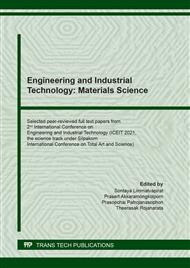p.23
p.31
p.37
p.45
p.53
p.63
p.69
p.75
p.81
Assessment of Shellac as Alternative Material for Preparation of Fused Deposition Modeling (FDM) 3D Printing Filaments
Abstract:
The objective of this study was to assess feasibility of applying shellac as a biopolymer filament for using in fused deposition modeling (FDM) 3D printing. The shellac matrices were prepared through hot melt process by heating the ground shellac samples at 80°C in a silicone oil bath under continuous stirring for 15 min. Accelerated stability testing (annealing process) was also performed in order to evaluated thermal stability by re-heating shellac matrices at 80 °C for 12 h and 24 h in a hot air oven. The shellac matrices and annealed shellac matrices were then comparatively characterized. In the present study, all shellac matrices were investigated for physical appearance, acid value, insoluble solid, moisture content and also characterized by instrument analysis including Fourier-transform infrared (FTIR) spectroscopy, powder X-ray diffractometry (PXRD) and thermal analysis. The results demonstrated that shellac with initial heat (80°C, 15 min) and annealed at 80°C for 12 h had similar properties except the annealed shellac at 80°C for 24 h which shown the lower acid value and formed insoluble solid. The melting temperature, decomposition temperature and melting enthalpy of shellac were around 63-64°C, over than 200°C and 23 J/g, respectively. Furthermore, the extruded filament based on shellac was achieved by hot melt extrusion (HME) technique. The findings revealed that the shellac properties might be suitable to fabricate FDM filaments.
Info:
Periodical:
Pages:
53-62
Citation:
Online since:
March 2022
Price:
Сopyright:
© 2022 Trans Tech Publications Ltd. All Rights Reserved
Share:
Citation:


